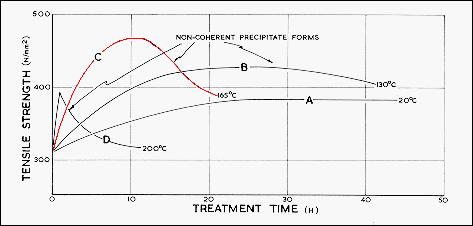| |
The effect
on the tensile strength of heating the quenched sample to various temperatures
and holding these constant for various times is shown in the diagram.
A shows the effect of holding the sample at room temperature for about 50 h;
its tensile strength first increases from that associated with the supersaturated
quenched alloy and plateaus after about 20 h. This process is known as
natural ageing. If the heat treating temperature is increased to 130 C (B)
the tensile strength increases more rapidly than in (A), reaches a maximum after
25 h, and then starts to decrease. When the process is performed at 165
C the rate of tensile strength increase is faster, the maximum value higher,
and the decrease after the maximum more rapid. If the sample is reduced to room
temperature after 10 h it will retain its high tensile strength at that temperature.
This heat treatment is known as artificial ageing and is a good choice
for heat treating a structural component made from this alloy. Curve (D)
shows the effect of overheating the quenched sample. Its tensile strength
starts to increase rapidly, but then drops rapidly back to its initial value.
This sample is said to be overaged. |
